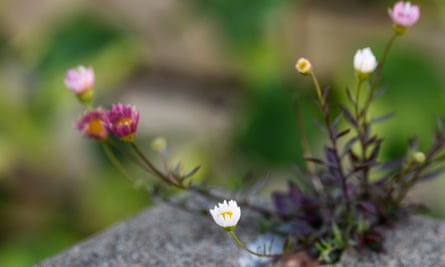
Four years ago, I moved into a terrace house in Bristol. It hadn’t been touched in years: a 1960s time warp with woodchip wallpaper, brown carpet in the bathroom and polystyrene ceiling tiles. Under the shadow of a pebble-dash facade, the front garden was a small patch of grass with one sad hydrangea. The grass was on compacted clay, which became waterlogged in winter and dry like asphalt in summer, making it difficult to grow anything but the toughest shrubs.
After stripping out the property and adding a kitchen extension, I was left with builders’ waste strewn across my garden and piled up in sacks. Rather than order another skip, I decided to turn my front plot into a rubble garden.

Recycling waste materials was all the rage at Chelsea flower show this year – Sarah Price used reclaimed materials such as old bricks and recycled plastic for her Benton End-inspired garden – but people have been experimenting with it for years. The horticultural professor and plantsman James Hitchmough has created beautiful meadows on crushed concrete buildings at the offices of Fidelity International in Tonbridge, Kent. It was this that sparked my idea. I wanted to save a skip of waste from going to landfill, while also creating conditions that would allow me to grow an interesting, biodiverse range of plants, which were low maintenance and wouldn’t need watering.
It is a myth that we need rich, fertile soil to garden on. While this might be necessary for growing prize dahlias or courgettes, these soils produce overfed plants which struggle to deal with drought and need constant watering. They also provide a fertile home for weeds – think of stinging nettles thriving on a nitrogen-rich riverbank – and create a cycle of maintenance-intensive gardening. Switching to growing in sand and gravel will make it harder for weeds to establish and will reduce the vigour of those that do.

Poorer, unimproved soils, such as sand, gravel or even rubble, offer a new way forward – gardens more adept at dealing with the challenge of the climate crisis. Poor soils produce shorter, sturdier and more resilient and drought-tolerant plants. Constant winter rain can be as dangerous as summer drought to garden plants, especially to our popular perennials such as salvias, achillea and echinacea. These, and many other plants, hate to sit in the wet ground over winter with their roots waterlogged. Embracing new soils improves drainage: while sand is one choice, green-roof substrates or gravel can also be used.
I spread 30cm of crushed old plaster and sand over the existing lawn in my front garden, as neighbours watched on bemused. I decided on a naturalistic style with grasses at the core and a wide range of bulbs and flowers. I planted it in autumn, sowing annual seeds such as California poppies, cornflowers and Ammi majus, alongside perennials such as achilleas, erigeron and salvias.
That first winter, people kept asking me when I was going to “do my garden”. The garden path led through a grey sea of rubble. However, when spring arrived, that changed as waves of bulbs flowered. The stony soil is perfect for alliums and tulips, reminiscent of their native habitats, the rocky hillsides of the Middle East.

Plants grow more slowly in these poorer soils, but by the second year the garden was filled with bright green Sesleria autumnalis (a grass), purple spires of salvias, and catmint spilling over the path. The garden has never been watered and needs just a quick weed in the autumn, when I sometimes add new bulbs.
One of the best-known advocates of this style of gardening is Swedish nurseryman Peter Korn. After years of studying plants in their natural habitats, Korn pioneered a method of growing plants in pure sand. Despite recent summer droughts he never waters them, and his Malmö garden is stunning.
Nigel Dunnett, mastermind of planting at the London Olympic Park and Tower of London Superbloom, has designed rain gardens in Sheffield city centre, which take runoff from the roads and let it soak back into the subsoil, rather than overloading the sewers. Dunnett’s central reservations resemble gardens at Chelsea flower show, with alliums and beautiful Eremurus thriving in the gravel.
At Knepp Castle Estate in West Sussex, owners Charlie Burrell and Isabella Tree recently rewilded their walled garden with the hope of increasing the biodiversity of wildlife within. Concrete farm buildings on the site were being demolished anyway, so this material was crushed, mixed with sand and spread over the site in undulating mounds. This harsh soil is perfect for increasing biodiversity as it is hard for a single plant to become too big and dominate. While the garden is still establishing, it has been planted with more than 800 species of plants. This immense variety of planting will be able to support incredible insect biodiversity.

This summer, heat radiates off the asphalt around me. But as I step into my front garden, tall grasses sway in the evening light, pink dianthus pop and a bee settles on the spiky flower of an electric-blue eryngium.
Could this be the future of our gardens?
How to create your own rubble garden
Materials
Use gravel, crushed brick or concrete and sharp sand (but note that builders’ sand is too fine to be used on its own and can become waterlogged). Try to recycle material you already have on site.
When and how to plant
Autumn gives your plants time to settle into their new surroundings. Go for bare-root plants, as this helps them adapt to their soil and send out deep roots.
Give the plants an initial long soaking with a hosepipe and then leave them. (If you’re planting in spring, irrigate for the first few months.)
A high planting density is recommended – six to 10 plants per square metre.
What to plant
Grasses: Stipa tenuissima, Sesleria autumnalis, Stipa gigantea.
Try to choose some plants that will flower at different times of the year, to give you a long season of colour.
To flower in May/June: Salvia nemorosa ‘Caradonna’, Achillea ‘Terracotta’, Lychnis coronaria, Calamintha nepeta ‘Walkers Low’.
July/August: Eryngium ‘Big Blue’, Echinacea pallida, Erigeron karvinskianus, Verbena bonariensis, aster frikartii ‘Mönch’, Salvia ‘Nachtvlinder’.
September/October: Aster ‘Little Carlow’, Salvia ‘Amistad’, Gaura lindheimeri.










 English (US)
English (US)